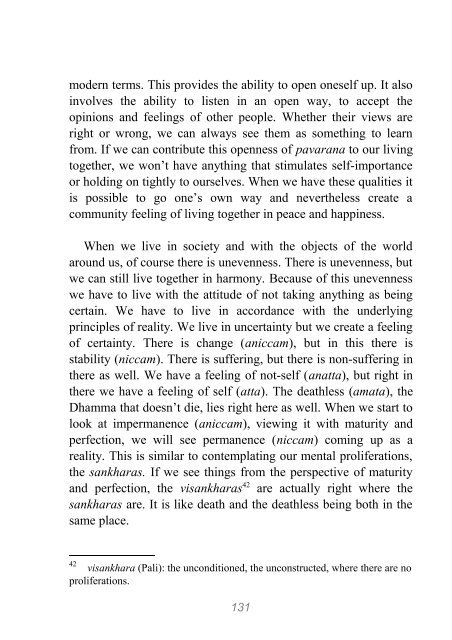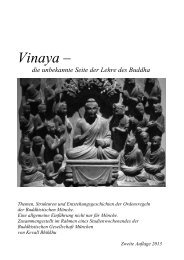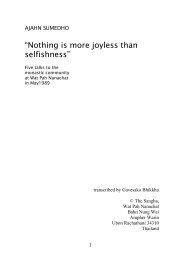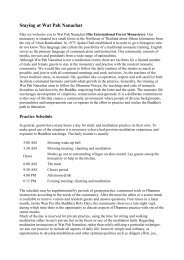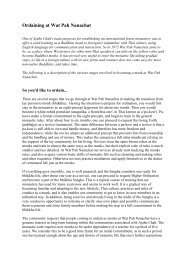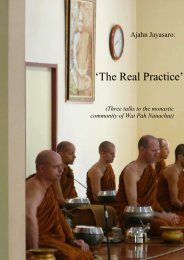Luang Por Liem: The Ways of the Peaceful - Wat Pah Nanachat
Luang Por Liem: The Ways of the Peaceful - Wat Pah Nanachat
Luang Por Liem: The Ways of the Peaceful - Wat Pah Nanachat
You also want an ePaper? Increase the reach of your titles
YUMPU automatically turns print PDFs into web optimized ePapers that Google loves.
modern terms. This provides <strong>the</strong> ability to open oneself up. It also<br />
involves <strong>the</strong> ability to listen in an open way, to accept <strong>the</strong><br />
opinions and feelings <strong>of</strong> o<strong>the</strong>r people. Whe<strong>the</strong>r <strong>the</strong>ir views are<br />
right or wrong, we can always see <strong>the</strong>m as something to learn<br />
from. If we can contribute this openness <strong>of</strong> pavarana to our living<br />
toge<strong>the</strong>r, we won’t have anything that stimulates self-importance<br />
or holding on tightly to ourselves. When we have <strong>the</strong>se qualities it<br />
is possible to go one’s own way and never<strong>the</strong>less create a<br />
community feeling <strong>of</strong> living toge<strong>the</strong>r in peace and happiness.<br />
When we live in society and with <strong>the</strong> objects <strong>of</strong> <strong>the</strong> world<br />
around us, <strong>of</strong> course <strong>the</strong>re is unevenness. <strong>The</strong>re is unevenness, but<br />
we can still live toge<strong>the</strong>r in harmony. Because <strong>of</strong> this unevenness<br />
we have to live with <strong>the</strong> attitude <strong>of</strong> not taking anything as being<br />
certain. We have to live in accordance with <strong>the</strong> underlying<br />
principles <strong>of</strong> reality. We live in uncertainty but we create a feeling<br />
<strong>of</strong> certainty. <strong>The</strong>re is change (aniccam), but in this <strong>the</strong>re is<br />
stability (niccam). <strong>The</strong>re is suffering, but <strong>the</strong>re is non-suffering in<br />
<strong>the</strong>re as well. We have a feeling <strong>of</strong> not-self (anatta), but right in<br />
<strong>the</strong>re we have a feeling <strong>of</strong> self (atta). <strong>The</strong> deathless (amata), <strong>the</strong><br />
Dhamma that doesn’t die, lies right here as well. When we start to<br />
look at impermanence (aniccam), viewing it with maturity and<br />
perfection, we will see permanence (niccam) coming up as a<br />
reality. This is similar to contemplating our mental proliferations,<br />
<strong>the</strong> sankharas. If we see things from <strong>the</strong> perspective <strong>of</strong> maturity<br />
and perfection, <strong>the</strong> visankharas 42 are actually right where <strong>the</strong><br />
sankharas are. It is like death and <strong>the</strong> deathless being both in <strong>the</strong><br />
same place.<br />
42 visankhara (Pali): <strong>the</strong> unconditioned, <strong>the</strong> unconstructed, where <strong>the</strong>re are no<br />
proliferations.<br />
131


